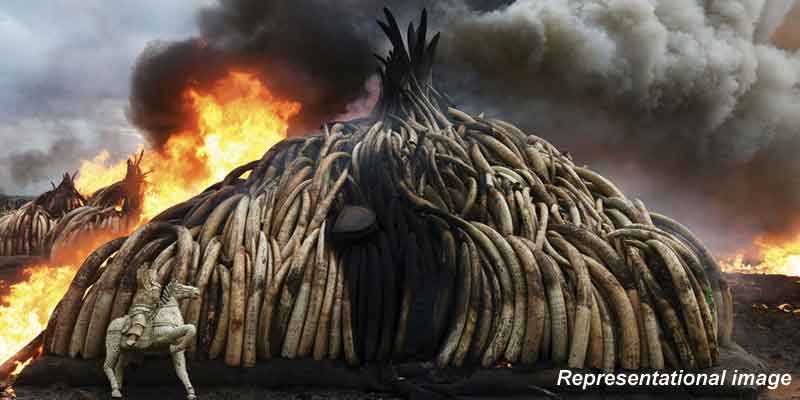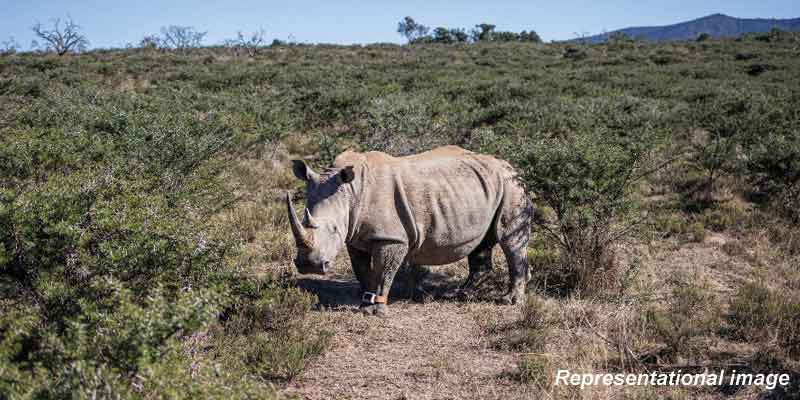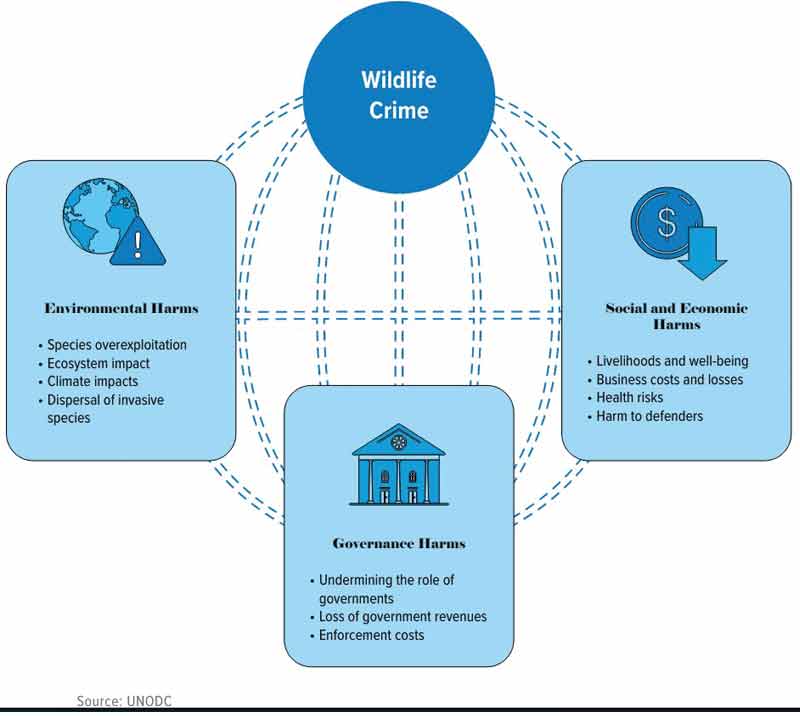- World
- May 18
Wildlife crime inflicts untold harm upon nature
• Despite two decades of worldwide efforts, more than 4,000 precious wildlife species still fall prey to trafficking every year.
• This was revealed in the ‘World Wildlife Crime Report’ of the United Nations Office on Drugs and Crime (UNODC).
• Although there are positive signs that trafficking of some iconic species has decreased, including elephants and rhinoceroses, thanks to the dismantling of large trafficking networks and the suppression of demand in key markets, the overall picture is still gloomy for thousands of protected plants and animals.
• Wildlife crime inflicts untold harm upon nature and it also jeopardizes livelihoods, public health, good governance and our planet’s ability to fight climate change.
• Wildlife crime has a profound global impact whose ramifications aren’t always clearly understood.
• There have been significant decreases in poaching, seizures, and market prices for these species over the past decade.
• More consistent enforcement to tackle both supply and demand, effective implementation of legislation, including anti-corruption laws, and stronger monitoring and research are needed.
The scale and harms of wildlife crime
• The analysis of over 140,000 wildlife species traffic seizures from 2015 to 2021 reveals the intricate involvement of powerful organised crime groups in exploiting fragile ecosystems worldwide.
• The global scope and scale of wildlife crime remain substantial, the report finds, with seizures during 2015–2021 indicating an illegal trade in 162 countries and territories affecting around 4,000 plant and animal species.
• Approximately 3,250 of these species are listed in the Convention on International Trade in Endangered Species of Wild Fauna and Flora (CITES).
• Over the reporting period, law enforcement bodies confiscated 13 million items totalling more than 16,000 tonnes.
• Some of the species worse affected — like rare orchids, succulents, reptiles, fish, birds and mammals — receive little public attention, though wildlife trafficking appears to have played a major role in their local or global extinctions.
• Beyond the direct threat to the population of species posed by wildlife trafficking, the crime can also disrupt delicate ecosystems and their functions and processes — including their ability to help stabilise the climate and mitigate climate change.
How traffickers operate?
• Wildlife crime is interconnected with the activities of large and powerful organised crime groups operating in some of the world’s most fragile and diverse ecosystems, from the Amazon to the Golden Triangle (broadly encompassing northeastern Myanmar, northwestern Thailand and northern Laos).
• The report notes that transnational organized crime groups are active in various roles along the trade chain, including export, import, brokering, storage, keeping and breeding live specimens or handling the interface with processors.
• Traffickers exploit inconsistencies and weaknesses in regulation and enforcement.
• Traffickers continuously adapt their methods and routes to evade detection and prosecution, exploiting regulatory loopholes and enforcement weaknesses.
• Corruption plays a key role in undermining regulation and enforcement actions against wildlife trade, yet wildlife crime cases are seldom prosecuted through corruption offences.
• More focus could be placed on prosecuting wildlife traffickers under anti-corruption laws, the report notes, which often offer enhanced investigative powers and higher penalties than those under environmental legislation.
Wildlife crime harms are diverse
i) Thousands of threatened wildlife species are affected:
The impact of wildlife trafficking on the conservation status of wildlife species is a critical concern driving policy attention to wildlife crime. A review of evidence about harms caused by wildlife crime in the current report makes it clear that thousands of threatened species are affected by wildlife trafficking, a small minority of which, such as elephants, tigers and rhinoceros, attract the majority of policy attention.
In fact, some of the clearest examples of conservation harm caused by wildlife crime receive comparatively little attention, such as the illegal collection of succulent plants and rare orchids, and the trafficking of a wide range of reptiles, fish, birds, and mammals for which illegal trade appears to have played a major role in local or global extinctions.
ii) Wildlife trafficking harms ecosystems and their climate-related functions:
On environmental harms beyond the immediate conservation threat to target species, population reductions caused by wildlife trafficking can play a role in triggering ecosystem-level impacts by disturbing interdependencies between different species and undermining related functions and processes.
This also has considerable potential to undermine the role that natural ecosystems play in long-term climate stability and mitigation of climate change impacts.
There is an emerging body of research on potential climate impacts of population reductions of various species affected by wildlife crime. It is also critical to keep in mind that this relationship works in both directions: climate change is likely to exacerbate natural resource conflicts and cause profound social changes that will likely lead to new motivations and opportunities for wildlife crime and new patterns of illegal wildlife trade.
iii) Wildlife crime harms socioeconomic development:
Species depletion and ecosystem disruption caused by wildlife crime can undermine the many socioeconomic benefits that people derive from nature. This includes loss of employment and other income from wildlife-based industries and degradation of the material benefits that nature provides to people, such as food, medicines and energy, as well as non-material contributions to identity, culture and learning.
Wildlife trafficking can also undermine the role nature plays in life support systems such as agriculture and water supply. Impacts of wildlife crime can extend to reduced security, exposure to violence, undermining community cohesion, and increased vulnerability to abusive employment practices and trafficking in persons.
Other potential social and economic impacts include harm to environmental defenders, increased health risks through disease transmission and negative effects on legitimate private sector interests.
iv) Governance is also impacted by wildlife crime:
Wildlife trafficking can also have a corrosive influence on governance and the rule of law through corruption, money-laundering and illegal cross-border financial flows. It can also reduce government revenues from legitimate trade, such as licence fees from legal timber harvest and export, and other uses of nature, such as taxation from tourism business. Tackling wildlife trafficking has significant associated government budget costs.
What is the role of UNODC?
• The United Nations Office on Drugs and Crime (UNODC) contributes to global peace and security, sustainable development and human rights by helping to make the world safer from drugs, crime, corruption and terrorism.
• Established in 1997 through a merger between the UN Drug Control Programme and the Centre for International Crime Prevention, UNODC operates in all regions of the world through an extensive network of field offices. UNODC relies on voluntary contributions, mainly from governments, for 90 per cent of its budget.
• UNODC provides technical assistance, research and normative support to Member States to help them develop and implement comprehensive, evidence-based solutions to the complex and interconnected threats that they face at the national, regional and global levels.
• It is headquartered in Vienna with a network of over 130 offices around the world.
• UNODC relies on voluntary contributions, mainly from governments, to carry out the majority of our work.
Main functions of UNODC:
i) Tackling the world drug problem through balanced, evidence-based responses to address drug abuse and drug use disorders, as well as the production and trafficking of illicit drugs.
ii) Preventing corruption by promoting integrity and good governance and helping recover stolen assets.
iii) Countering terrorism through effective, accountable and inclusive legal, crime prevention and criminal justice measures in line with international norms and the UN Global Counter Terrorism Strategy.
iv) Combating organised crime by providing technical assistance and support and strengthening international cooperation to address organized criminal activity and all forms of trafficking.
v) Preventing crime and promoting criminal justice through human rights-based and victim-centered approaches that strengthen the rule of law and access to justice.
Manorama Yearbook app is now available on Google Play Store and iOS App Store



